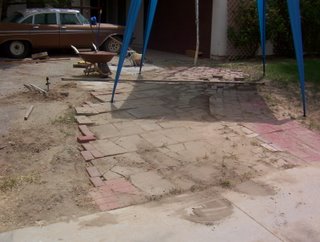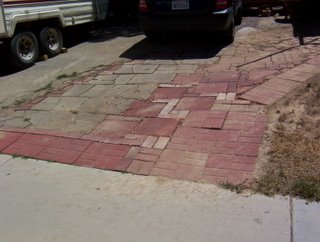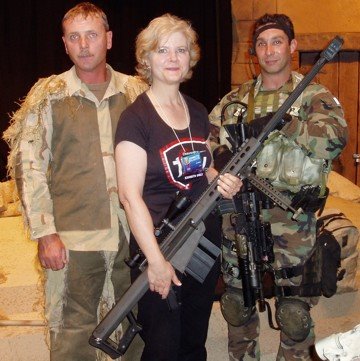DIY Driveway Exension
Some things I do myself. Some things I hire somebody to do. Some things that I would hire somebody to do at my own house, I get roped into doing for my dad. The (cue ominous music) driveway extension project is one of those things.
It all started when my folks got a notice from the city that their trailer did not comply with code, since it wasn't parked on pavement. Following their initial indignation, since the trailer had been parked on a driveway extension of bricks and pavers, my folks could see how someone might have thought the area wasn't paved. When the plumbers had fixed the sewer (digging a trench through the driveway), they had tossed the spoil dirt under the trailer on top of the pavers. So my mother called the city and got a month to fix the problem - the hottest month of the year, it turned out - instead of the five days originally allotted.
Daddy decided that the gray pavers and fired bricks weren't sufficiently visible, since they were essentially dirt-color, so he bought red pavers to add to the extent of the paved area. He began work with the trailer still in place, using jacks to lift the tires to slide bricks underneath. Mother and I finally persuaded him to move the trailer using the Jeep truck, which is underpowered but still managed to get the trailer moved to the main driveway so that the work area was clear.

Then we got to work. The pavers and bricks were different thicknesses, making it particularly difficult to line up the tops when the bricks needed to be buried deeper. Laying in the borders first was not the best idea, either, since we then had to piece in the middle part; it would have been better to start at a corner and worked our way outward.
The best I can say about the finished project is that it does the job, and it looks better than it did. It's also done.

This looks like fields in the midwest when you fly over them, doesn't it?
Yesterday when I went to Lancaster, the only thing left for me to do on the driveway project was take pictures and guide my dad in re-parking the trailer. This was a good thing, since I had a lot of other stuff to do, including downloading Norton Antivirus 2006 via dialup (and installing it, but that was no biggie) and taking my dad to buy the dishwasher my mother wanted.
It all started when my folks got a notice from the city that their trailer did not comply with code, since it wasn't parked on pavement. Following their initial indignation, since the trailer had been parked on a driveway extension of bricks and pavers, my folks could see how someone might have thought the area wasn't paved. When the plumbers had fixed the sewer (digging a trench through the driveway), they had tossed the spoil dirt under the trailer on top of the pavers. So my mother called the city and got a month to fix the problem - the hottest month of the year, it turned out - instead of the five days originally allotted.
Daddy decided that the gray pavers and fired bricks weren't sufficiently visible, since they were essentially dirt-color, so he bought red pavers to add to the extent of the paved area. He began work with the trailer still in place, using jacks to lift the tires to slide bricks underneath. Mother and I finally persuaded him to move the trailer using the Jeep truck, which is underpowered but still managed to get the trailer moved to the main driveway so that the work area was clear.

This is what it looked like right after we moved the trailer.
Then we got to work. The pavers and bricks were different thicknesses, making it particularly difficult to line up the tops when the bricks needed to be buried deeper. Laying in the borders first was not the best idea, either, since we then had to piece in the middle part; it would have been better to start at a corner and worked our way outward.
The best I can say about the finished project is that it does the job, and it looks better than it did. It's also done.

This looks like fields in the midwest when you fly over them, doesn't it?
Yesterday when I went to Lancaster, the only thing left for me to do on the driveway project was take pictures and guide my dad in re-parking the trailer. This was a good thing, since I had a lot of other stuff to do, including downloading Norton Antivirus 2006 via dialup (and installing it, but that was no biggie) and taking my dad to buy the dishwasher my mother wanted.

